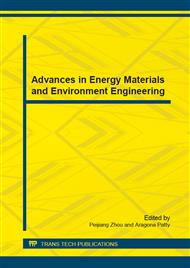[1]
Global wind energy council, Global wind report: Annual market update 2013, Brussels, Belgium, (2014).
Google Scholar
[2]
H. Nwana and L. Lee and N. Jennings, Coordination inSoftware Agent Systems, In the British Telecom Technical JournalVol. 14, No 4, pp.79-88, (1996).
Google Scholar
[3]
M. Schumacher, Multi-agent Systems, In Objective Coordination inMulti-agent Systems Engineering: Design and Implementation, Editor, Lecture Notes in Artificial Intelligence, Vol. 2039, Springer Verlag, Heidelberg, Germany, April (2001).
Google Scholar
[4]
A. Bedrouni, R. Mittu, A. Boukhtouta, J. Berger, Distributed Intelligent Systems A Coordination Perspective, Springer Science+Business Media , ISBN 978-0-387-77701-6.
DOI: 10.1007/978-0-387-77702-3
Google Scholar
[5]
J. Vidal, Fundamentals of Multiagent Systems with NetLogoExamples, August 24, (2007).
Google Scholar
[6]
C. Petrie, T. Webster, and M. Cutkosky. Using ParetoOptimality to Coordinate Distributed Agents. Artificial Intelligencefor Engineering Design, Analysis and Manufacturing, 9: 269–281, (1995).
DOI: 10.1017/s0890060400002821
Google Scholar
[7]
C. Coello, G. Lamont and D. Van Veldhuizen, Evolutionary Algorithms for Solving Multi-Objective Problems, Second Edition, 2007 Springer Science+Business Media, LLC, ISBN 978-0-387-33254-3.
DOI: 10.1007/978-1-4757-5184-0
Google Scholar
[8]
M. Ehrgott. Multicriteria Optimization. Springer, Berlin, second edition, 2005. ISBN 3-540-21398-8.
Google Scholar
[9]
Pareto. Cours D'Economie Politique, volume I and II. F. Rouge, Lausanne, 1896.
Google Scholar
[10]
D. Van Veldhuizen. Multiobjective Evolutionary Algorithms: Classifications, Analyses, and New Innovations. PhD thesis, Department of Electrical and Computer Engineering. GraduateSchool of Engineering. Air Force Institute of Technology, Wright- Patterson AFB, Ohio, May (1999).
Google Scholar
[11]
C. Coello and G. Lamont, editors. Applications of Multi-Objective Evolutionary Algorithms. World Scientific, Singapore, 2004. ISBN 981-256-106-4.
Google Scholar
[12]
C. Coello. Theoretical and Numerical Constraint Handling Techniques used with Evolutionary Algorithms: A Survey of the State of the Art. Computer Methods in Applied Mechanics and Engineering, 191(11–12): 1245–1287, January (2002).
DOI: 10.1016/s0045-7825(01)00323-1
Google Scholar
[13]
K. Deb,A. Pratap, S. Agrawal&T. Meyarivan. (2002). A fastelitist non-dominated sorting genetic algorithm for multi-objectiveoptimization: NSGA-II. IEEE Transactions on EvolutionaryComputation, 6(2), 182–197. (Also KanGAL Report No. 2000001).
DOI: 10.1109/4235.996017
Google Scholar
[14]
O. Rudenko, M. Schoenauer. A Steady Performance StoppingCriterion for Pareto-based Evolutionary Algorithms. Centre deMathematiques Appliqu'ees, Ecole Polytechnique, unpublished.
Google Scholar
[15]
M. Mauledoux, V. Shkodyrev, Genetics algorithms for solving multiobjectiveoptimizationof robotscooperative behavior problems, technical-scientific magazin SPBGPU vol 4 2009, pp.157-164, ISSN1994-2354.
Google Scholar
[16]
K. Sastry, Single and Multiobjective Genetic AlgorithmToolbox for Matlab in C++, IlliGAL Report No. 2007017, June2007, unpublished.
Google Scholar


